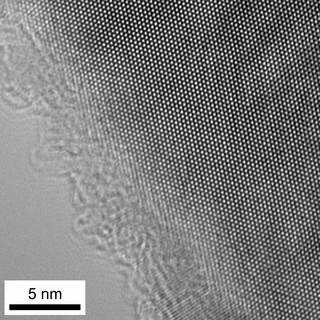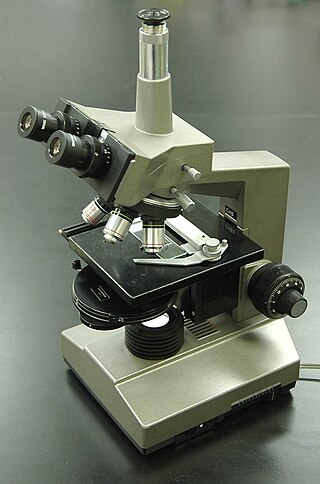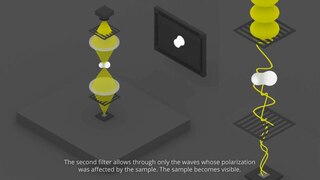Related Research Articles

Microscopy is the technical field of using microscopes to view objects and areas of objects that cannot be seen with the naked eye. There are three well-known branches of microscopy: optical, electron, and scanning probe microscopy, along with the emerging field of X-ray microscopy.

A microscope is a laboratory instrument used to examine objects that are too small to be seen by the naked eye. Microscopy is the science of investigating small objects and structures using a microscope. Microscopic means being invisible to the eye unless aided by a microscope.

The optical microscope, also referred to as a light microscope, is a type of microscope that commonly uses visible light and a system of lenses to generate magnified images of small objects. Optical microscopes are the oldest design of microscope and were possibly invented in their present compound form in the 17th century. Basic optical microscopes can be very simple, although many complex designs aim to improve resolution and sample contrast.

High-resolution transmission electron microscopy is an imaging mode of specialized transmission electron microscopes that allows for direct imaging of the atomic structure of samples. It is a powerful tool to study properties of materials on the atomic scale, such as semiconductors, metals, nanoparticles and sp2-bonded carbon. While this term is often also used to refer to high resolution scanning transmission electron microscopy, mostly in high angle annular dark field mode, this article describes mainly the imaging of an object by recording the two-dimensional spatial wave amplitude distribution in the image plane, similar to a "classic" light microscope. For disambiguation, the technique is also often referred to as phase contrast transmission electron microscopy, although this term is less appropriate. At present, the highest point resolution realised in high resolution transmission electron microscopy is around 0.5 ångströms (0.050 nm). At these small scales, individual atoms of a crystal and defects can be resolved. For 3-dimensional crystals, it is necessary to combine several views, taken from different angles, into a 3D map. This technique is called electron tomography.
Georges (Jerzy) Nomarski was a Polish physicist and optics theoretician. Creator of differential interference contrast (DIC) microscopy, the method is widely used to study live biological specimens and unstained tissues and in many languages bears his name.

Differential interference contrast (DIC) microscopy, also known as Nomarski interference contrast (NIC) or Nomarski microscopy, is an optical microscopy technique used to enhance the contrast in unstained, transparent samples. DIC works on the principle of interferometry to gain information about the optical path length of the sample, to see otherwise invisible features. A relatively complex optical system produces an image with the object appearing black to white on a grey background. This image is similar to that obtained by phase contrast microscopy but without the bright diffraction halo. The technique was invented by Francis Hughes Smith. The "Smith DIK" was produced by Ernst Leitz Wetzlar in Germany and was difficult to manufacture. DIC was then developed further by Polish physicist Georges Nomarski in 1952.

Dark-field microscopy describes microscopy methods, in both light and electron microscopy, which exclude the unscattered beam from the image. As a result, the field around the specimen is generally dark.
Nanovid microscopy, from "nanometer video-enhanced microscopy", is a microscopic technique aimed at visualizing colloidal gold particles of 20–40 nm diameter as dynamic markers at the light-microscopic level. The nanogold particles as such are smaller than the diffraction limit of light, but can be visualized by using video-enhanced differential interference contrast (VEDIC). The technique is based on the use of contrast enhancement by video techniques and digital image processing. Nanovid microscopy, by combining small colloidal gold probes with video-enhanced quantitative microscopy, allows studying the intracellular dynamics of specific proteins in living cells.

Bright-field microscopy (BF) is the simplest of all the optical microscopy illumination techniques. Sample illumination is transmitted white light, and contrast in the sample is caused by attenuation of the transmitted light in dense areas of the sample. Bright-field microscopy is the simplest of a range of techniques used for illumination of samples in light microscopes, and its simplicity makes it a popular technique. The typical appearance of a bright-field microscopy image is a dark sample on a bright background, hence the name.

Phase-contrast microscopy (PCM) is an optical microscopy technique that converts phase shifts in light passing through a transparent specimen to brightness changes in the image. Phase shifts themselves are invisible, but become visible when shown as brightness variations.
Classical interference microscopy, also called quantitative interference microscopy, uses two separate light beams with much greater lateral separation than that used in phase contrast microscopy or in differential interference microscopy (DIC).

Interference reflection microscopy (IRM), also called Reflection Interference Contrast Microscopy (RICM) or Reflection Contrast Microscopy (RCM) depending on the context, is an optical microscopy technique that leverages interference effects to form an image of an object on a glass surface. The intensity of the signal is a measure of proximity of the object to the glass surface. This technique can be used to study events at the cell membrane without the use of a (fluorescent) label as is the case for TIRF microscopy.

Polarized light microscopy can mean any of a number of optical microscopy techniques involving polarized light. Simple techniques include illumination of the sample with polarized light. Directly transmitted light can, optionally, be blocked with a polariser orientated at 90 degrees to the illumination. More complex microscopy techniques which take advantage of polarized light include differential interference contrast microscopy and interference reflection microscopy. Scientists will often use a device called a polarizing plate to convert natural light into polarized light.

Hoffman modulation contrast microscopy is an optical microscopy technique for enhancing the contrast in unstained biological specimens. The technique was invented by Robert Hoffman in 1975. Like differential interference contrast microscopy, contrast is increased by using components in the light path which convert phase gradients in the specimen into differences in light intensity that are rendered in an image that appears three-dimensional. The 3D appearance may be misleading, as a feature which appears to cast a shadow may not necessarily have a distinct physical geometry corresponding to the shadow. The technique is particularly suitable for optical sectioning at lower magnifications.
A phase telescope or Bertrand lens is an optical device used in aligning the various optical components of a light microscope. In particular it allows observation of the back focal plane of the objective lens and its conjugated focal planes. The phase telescope/Bertrand lens is inserted into the microscope in place of an eyepiece to move the intermediate image plane to a point where it can be observed.
Holographic interference microscopy (HIM) is holographic interferometry applied for microscopy for visualization of phase micro-objects. Phase micro-objects are invisible because they do not change intensity of light, they insert only invisible phase shifts. The holographic interference microscopy distinguishes itself from other microscopy methods by using a hologram and the interference for converting invisible phase shifts into intensity changes.

Quantitative phase contrast microscopy or quantitative phase imaging are the collective names for a group of microscopy methods that quantify the phase shift that occurs when light waves pass through a more optically dense object.
Gabriel Popescu was a Romanian-American optical engineer, who was the William L. Everitt Distinguished Professor in Electrical and Computer Engineering at University of Illinois Urbana-Champaign. He was best known for his work on biomedical optics and quantitative phase-contrast microscopy.